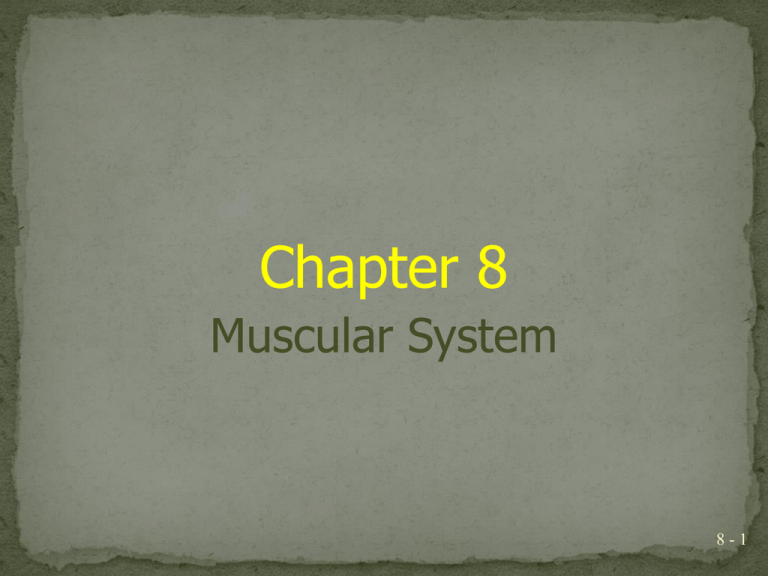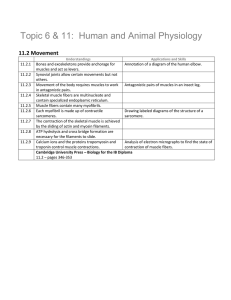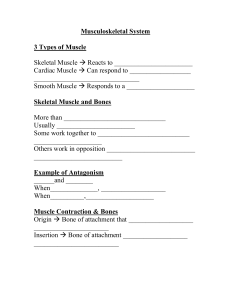Chapter 8 Muscular System 8 - 1
advertisement

Chapter 8 Muscular System 8-1 CopyrightThe McGraw-Hill Companies, Inc. Permission required for reproduction or display. Recap: -The three types of muscle in the body are skeletal, smooth, and cardiac muscle. 8-2 CopyrightThe McGraw-Hill Companies, Inc. Permission required for reproduction or display. Structure of a Skeletal Muscle Each muscle is an organ comprised of -skeletal muscle tissue -connective tissues -nervous tissue -blood 8-3 CopyrightThe McGraw-Hill Companies, Inc. Permission required for reproduction or display. 8-4 CopyrightThe McGraw-Hill Companies, Inc. Permission required for reproduction or display. Connective Tissue Coverings Fascia: Layers of dense connective tissue that surround and separate each muscle. Fascia extends beyond the ends of the muscle and gives rise to tendons which are fused to bones 8-5 CopyrightThe McGraw-Hill Companies, Inc. Permission required fo reproduction or display Epimysium: The layer of connective tissue around each whole muscle Perimysium : The layer of connective tissue surrounding individual bundles (fascicles) within each muscle Endomysium: The layer of connective tissue around each muscle cell (fiber) 8-6 Skeletal Muscle Fibers CopyrightThe McGraw-Hill Companies, Inc. Permission required for reproduction or display. -Each muscle fiber is a single cell with… -Sarcolemma: cell membrane -Sarcoplasm : cytoplasm containing many mitochondria and nuclei -Myofibrils: organelles that are separated into compartments called sarcomeres -Sarcomeres: structures that have thick and thin protein filaments 8-7 8-8 CopyrightThe McGraw-Hill Companies, Inc. Permission required for reproduction or display. The Sarcomere: -Thick filaments of myofibrils are made up of the protein myosin. -Thin filaments of myofibrils are made up of the protein actin. -The organization of these filaments produces striations. 8-9 8 - 10 8 - 11 CopyrightThe McGraw-Hill Companies, Inc. Permission required for reproduction or display. A sarcomere extends from Z line to Z line. -I bands (light bands) made up of actin filaments are anchored to Z lines. -A bands (dark bands) are made up of overlapping thick and thin filaments. -In the center of A bands is an H zone, consisting of myosin filaments only. 8 - 12 CopyrightThe McGraw-Hill Companies, Inc. Permission required for reproduction or display. 8 - 13 CopyrightThe McGraw-Hill Companies, Inc. Permission required for reproduction or display. Skeletal Muscle Contraction Muscle contraction involves several components that result in -the shortening of sarcomeres -the pulling of the muscle against its attachments. 8 - 14 CopyrightThe McGraw-Hill Companies, Inc. Permission required for reproduction or display. -Sliding filament theory: the myosin attaches to the binding site on the actin filament, pulls and releases it *After release, it will move on to the next actin binding site 8 - 15 CopyrightThe McGraw-Hill Companies, Inc. Permission required for reproduction or display. Stimulus for Contraction 1. The motor neuron releases acetylcholine (signalled from brain) *Signals muscle to contract 2. Calcium is released 3. Myosin is able to bind to actin and the fiber contracts (sarcomeres shorten) How does this stop? 8 - 16 CopyrightThe McGraw-Hill Companies, Inc. Permission required for reproduction or display. 8 - 17 CopyrightThe McGraw-Hill Companies, Inc. Permission required for reproduction or display. 8 - 18 CopyrightThe McGraw-Hill Companies, Inc. Permission required for reproduction or display. Energy Sources for Contraction 1. Energy for contraction comes from ATP. 8 - 19 CopyrightThe McGraw-Hill Companies, Inc. Permission required for reproduction or display. Muscle Fatigue -Muscle Fatigue: A muscle loses its ability to contract during strenuous exercise -Usually arises from the accumulation of lactic acid (lowered pH) in the muscle. -As a result, no muscle response to stimulation 8 - 20 CopyrightThe McGraw-Hill Companies, Inc. Permission required for reproduction or display. Muscle Cramp Muscle cramp: sustained involuntary contraction *Changes in fluid around cell *Uncontrolled stimulation of muscle (dehydration…) 8 - 21 THRESHOLD STIMULUS Muscles will only respond (contract) if the stimulus strength reaches a certain point Minimum strength required to make a muscle fiber contract is called the THRESHOLD STIMULUS 8 - 22 ALL – OR – NONE RESPONSE Muscles can’t “partially” contract They will either contract fully or not at all Increasing the stimulus intensity does not increase the force of a single muscle’s response 8 - 23 Twitch: period of contraction and relaxation of a single muscle fiber Movements result from multiple muscle fibers contracting together Fast Twitch: weight lifting, sprints, Slow Twitch: low intensity, long distance run, swimming 8 - 24 CopyrightThe McGraw-Hill Companies, Inc. Permission required for reproduction or display. Skeletal muscle contracts involuntarily Can be caused by: *Muscle fatigue/strain *Stress/anxiety *Medication *Caffeine 8 - 25 MUSCLE TONE –Even at “rest” a muscle is contracting Important in maintaining posture When a person collapses, muscle tone has been lost 8 - 26 ISOTONIC - Muscle changes length and produces force; causes motion ○ Ex. Lifting weights ISOMETRIC - Muscle doesn’t move but creates force Ex. Yoga 8 - 27 CopyrightThe McGraw-Hill Companies, Inc. Permission required for reproduction or display. Smooth Muscles Smooth muscle cells: -elongated with tapered ends -lack striations tw0 relaxed smooth muscle cells 8 - 28 CopyrightThe McGraw-Hill Companies, Inc. Permission required for reproduction or display. Multiunit Blood vessels Iris of the eye Individual fibers Visceral Walls of hollow organs Sheets Self-stimulating and rhythmic Peristalsis in tubes and hollow organs 8 - 29 CopyrightThe McGraw-Hill Companies, Inc. Permission required for reproduction or display. Smooth Muscle Contraction -Slower to contract and relax than skeletal muscle -Can contract longer using the same amount of ATP (sustainable contractions) 8 - 30 CopyrightThe McGraw-Hill Companies, Inc. Permission required for reproduction or display. Cardiac Muscle - has structures that supply extra calcium, and can thus contract for longer periods - intercalated disks: join cells and transmit impulses throughout the heart - self-exciting and rhythmic - the whole heart contracts as a unit 8 - 31



